Exploring Information Systems & Big Data Analysis: A Detailed Report
VerifiedAdded on 2023/06/10
|9
|2044
|230
Report
AI Summary
This report provides a comprehensive overview of big data and its characteristics, emphasizing the 5 V's: Volume, Variety, Veracity, Value, and Velocity. It delves into the challenges associated with big data, such as the lack of skilled professionals, data security concerns, and the complexities of tool selection. Various techniques for analyzing big data are explored, including A/B testing, data mining, machine learning, factor analysis, and text analysis. The report highlights how big data technology supports businesses by enhancing customer insights, improving decision-making, and increasing overall productivity, using Unilever as a practical example. The conclusion reinforces the integral role of big data in modern organizations and the importance of effective analysis for gaining competitive advantages.
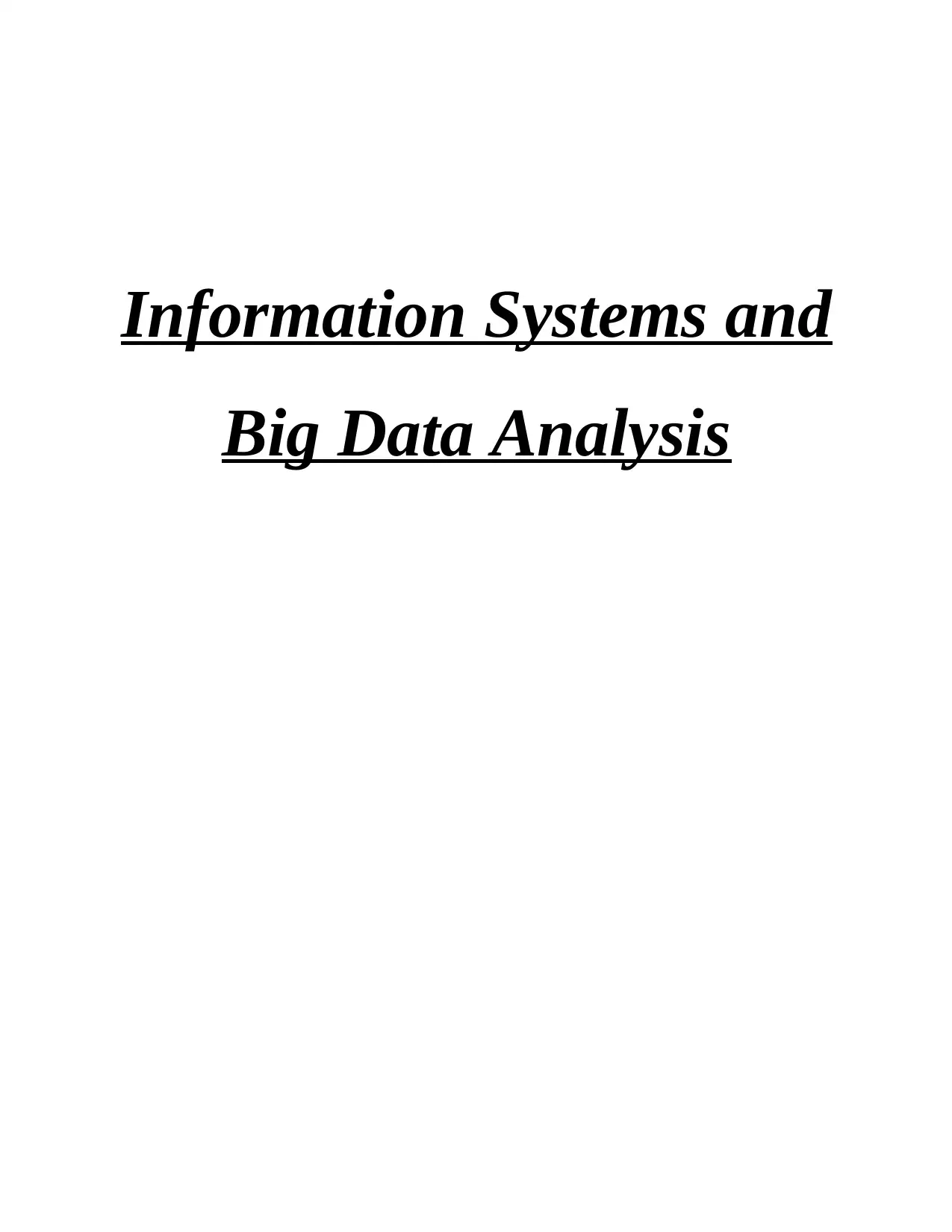
Information Systems and
Big Data Analysis
Big Data Analysis
Paraphrase This Document
Need a fresh take? Get an instant paraphrase of this document with our AI Paraphraser
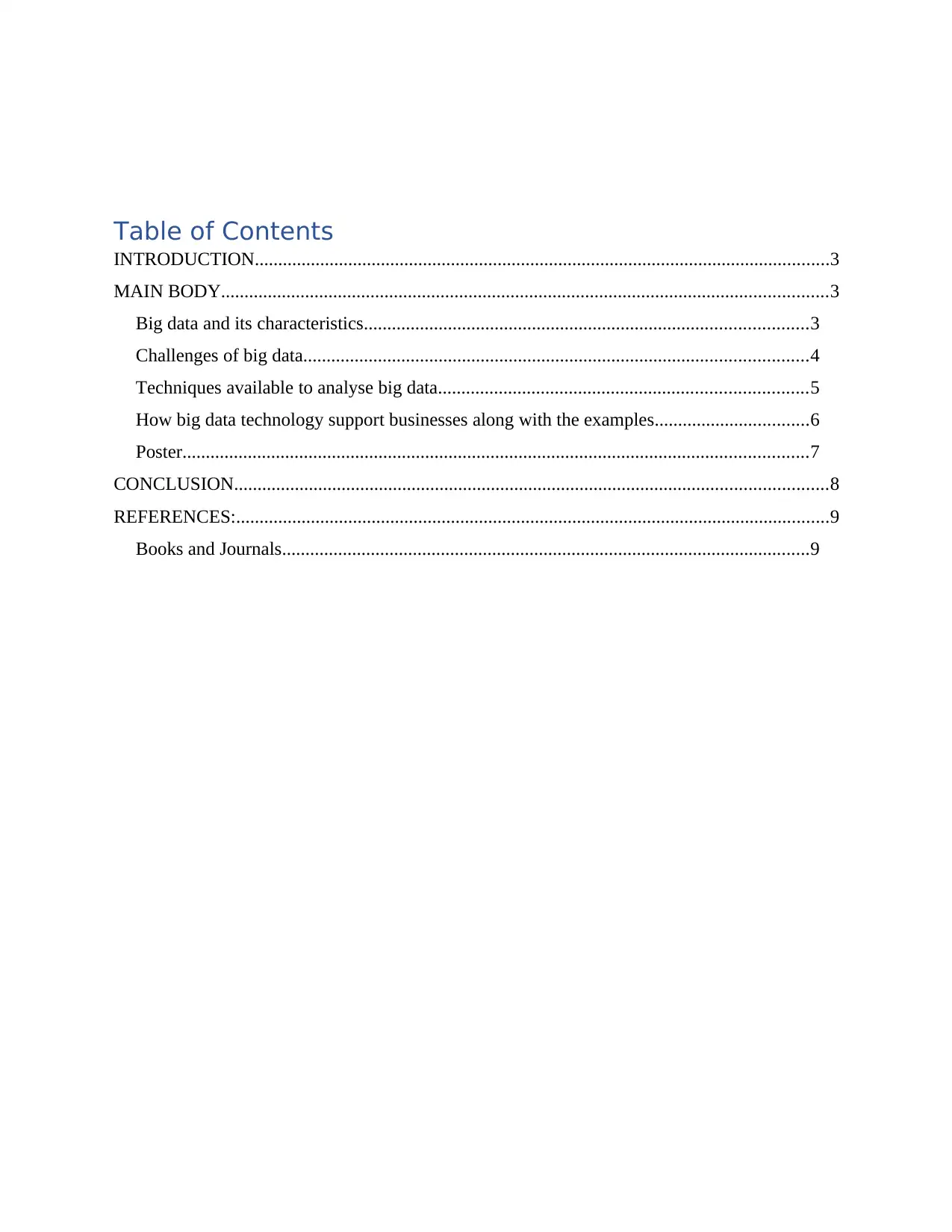
Table of Contents
INTRODUCTION...........................................................................................................................3
MAIN BODY..................................................................................................................................3
Big data and its characteristics...............................................................................................3
Challenges of big data............................................................................................................4
Techniques available to analyse big data...............................................................................5
How big data technology support businesses along with the examples.................................6
Poster......................................................................................................................................7
CONCLUSION...............................................................................................................................8
REFERENCES:...............................................................................................................................9
Books and Journals.................................................................................................................9
INTRODUCTION...........................................................................................................................3
MAIN BODY..................................................................................................................................3
Big data and its characteristics...............................................................................................3
Challenges of big data............................................................................................................4
Techniques available to analyse big data...............................................................................5
How big data technology support businesses along with the examples.................................6
Poster......................................................................................................................................7
CONCLUSION...............................................................................................................................8
REFERENCES:...............................................................................................................................9
Books and Journals.................................................................................................................9
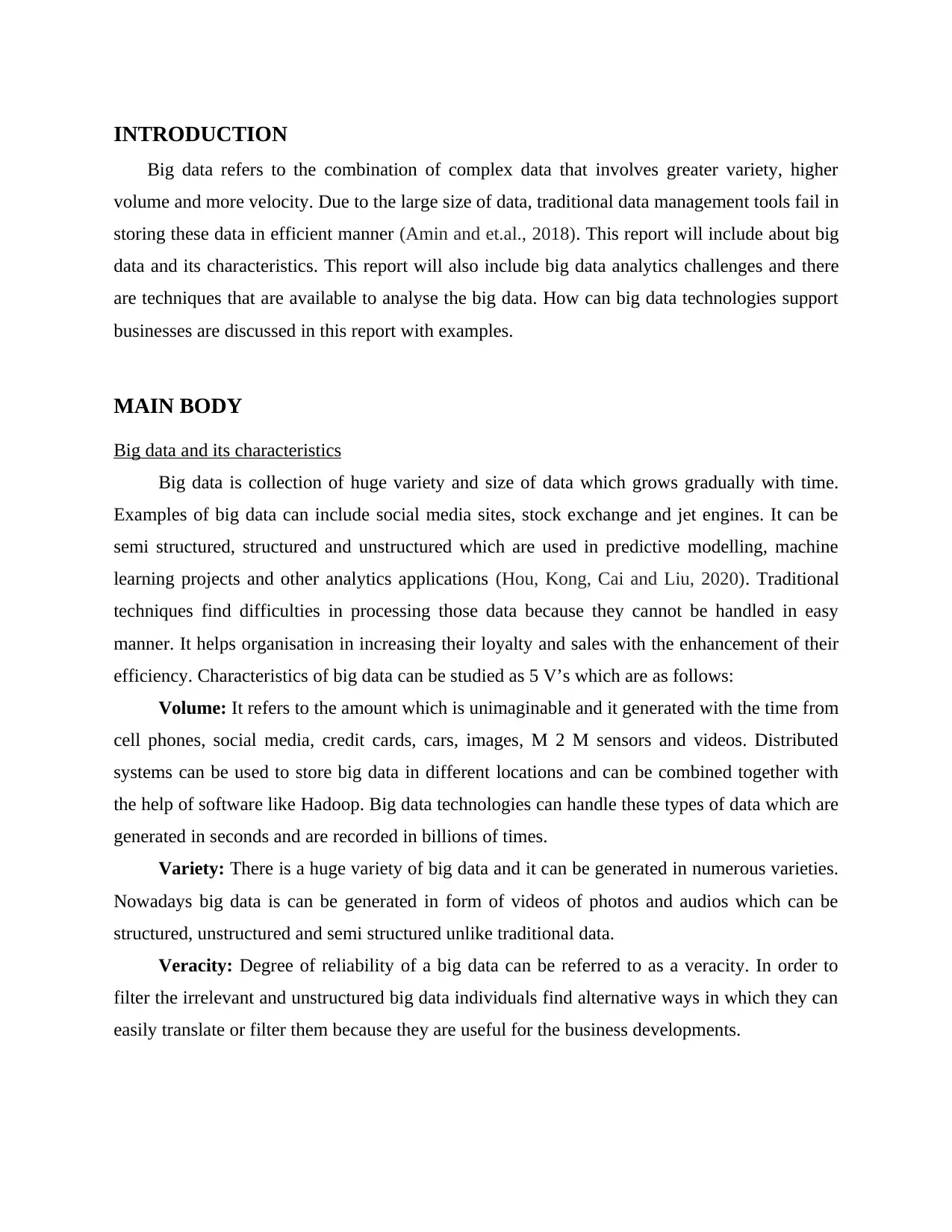
INTRODUCTION
Big data refers to the combination of complex data that involves greater variety, higher
volume and more velocity. Due to the large size of data, traditional data management tools fail in
storing these data in efficient manner (Amin and et.al., 2018). This report will include about big
data and its characteristics. This report will also include big data analytics challenges and there
are techniques that are available to analyse the big data. How can big data technologies support
businesses are discussed in this report with examples.
MAIN BODY
Big data and its characteristics
Big data is collection of huge variety and size of data which grows gradually with time.
Examples of big data can include social media sites, stock exchange and jet engines. It can be
semi structured, structured and unstructured which are used in predictive modelling, machine
learning projects and other analytics applications (Hou, Kong, Cai and Liu, 2020). Traditional
techniques find difficulties in processing those data because they cannot be handled in easy
manner. It helps organisation in increasing their loyalty and sales with the enhancement of their
efficiency. Characteristics of big data can be studied as 5 V’s which are as follows:
Volume: It refers to the amount which is unimaginable and it generated with the time from
cell phones, social media, credit cards, cars, images, M 2 M sensors and videos. Distributed
systems can be used to store big data in different locations and can be combined together with
the help of software like Hadoop. Big data technologies can handle these types of data which are
generated in seconds and are recorded in billions of times.
Variety: There is a huge variety of big data and it can be generated in numerous varieties.
Nowadays big data is can be generated in form of videos of photos and audios which can be
structured, unstructured and semi structured unlike traditional data.
Veracity: Degree of reliability of a big data can be referred to as a veracity. In order to
filter the irrelevant and unstructured big data individuals find alternative ways in which they can
easily translate or filter them because they are useful for the business developments.
Big data refers to the combination of complex data that involves greater variety, higher
volume and more velocity. Due to the large size of data, traditional data management tools fail in
storing these data in efficient manner (Amin and et.al., 2018). This report will include about big
data and its characteristics. This report will also include big data analytics challenges and there
are techniques that are available to analyse the big data. How can big data technologies support
businesses are discussed in this report with examples.
MAIN BODY
Big data and its characteristics
Big data is collection of huge variety and size of data which grows gradually with time.
Examples of big data can include social media sites, stock exchange and jet engines. It can be
semi structured, structured and unstructured which are used in predictive modelling, machine
learning projects and other analytics applications (Hou, Kong, Cai and Liu, 2020). Traditional
techniques find difficulties in processing those data because they cannot be handled in easy
manner. It helps organisation in increasing their loyalty and sales with the enhancement of their
efficiency. Characteristics of big data can be studied as 5 V’s which are as follows:
Volume: It refers to the amount which is unimaginable and it generated with the time from
cell phones, social media, credit cards, cars, images, M 2 M sensors and videos. Distributed
systems can be used to store big data in different locations and can be combined together with
the help of software like Hadoop. Big data technologies can handle these types of data which are
generated in seconds and are recorded in billions of times.
Variety: There is a huge variety of big data and it can be generated in numerous varieties.
Nowadays big data is can be generated in form of videos of photos and audios which can be
structured, unstructured and semi structured unlike traditional data.
Veracity: Degree of reliability of a big data can be referred to as a veracity. In order to
filter the irrelevant and unstructured big data individuals find alternative ways in which they can
easily translate or filter them because they are useful for the business developments.
⊘ This is a preview!⊘
Do you want full access?
Subscribe today to unlock all pages.

Trusted by 1+ million students worldwide
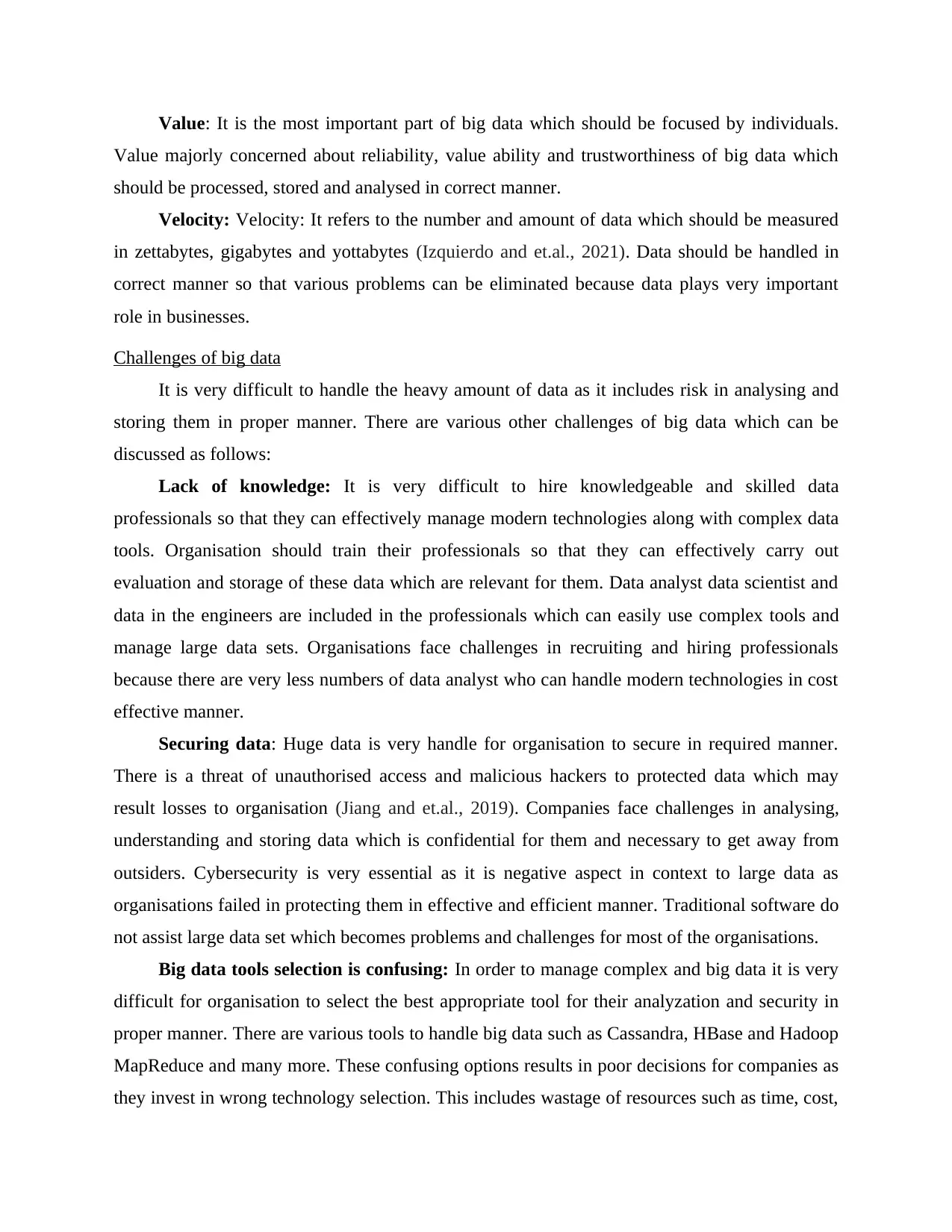
Value: It is the most important part of big data which should be focused by individuals.
Value majorly concerned about reliability, value ability and trustworthiness of big data which
should be processed, stored and analysed in correct manner.
Velocity: Velocity: It refers to the number and amount of data which should be measured
in zettabytes, gigabytes and yottabytes (Izquierdo and et.al., 2021). Data should be handled in
correct manner so that various problems can be eliminated because data plays very important
role in businesses.
Challenges of big data
It is very difficult to handle the heavy amount of data as it includes risk in analysing and
storing them in proper manner. There are various other challenges of big data which can be
discussed as follows:
Lack of knowledge: It is very difficult to hire knowledgeable and skilled data
professionals so that they can effectively manage modern technologies along with complex data
tools. Organisation should train their professionals so that they can effectively carry out
evaluation and storage of these data which are relevant for them. Data analyst data scientist and
data in the engineers are included in the professionals which can easily use complex tools and
manage large data sets. Organisations face challenges in recruiting and hiring professionals
because there are very less numbers of data analyst who can handle modern technologies in cost
effective manner.
Securing data: Huge data is very handle for organisation to secure in required manner.
There is a threat of unauthorised access and malicious hackers to protected data which may
result losses to organisation (Jiang and et.al., 2019). Companies face challenges in analysing,
understanding and storing data which is confidential for them and necessary to get away from
outsiders. Cybersecurity is very essential as it is negative aspect in context to large data as
organisations failed in protecting them in effective and efficient manner. Traditional software do
not assist large data set which becomes problems and challenges for most of the organisations.
Big data tools selection is confusing: In order to manage complex and big data it is very
difficult for organisation to select the best appropriate tool for their analyzation and security in
proper manner. There are various tools to handle big data such as Cassandra, HBase and Hadoop
MapReduce and many more. These confusing options results in poor decisions for companies as
they invest in wrong technology selection. This includes wastage of resources such as time, cost,
Value majorly concerned about reliability, value ability and trustworthiness of big data which
should be processed, stored and analysed in correct manner.
Velocity: Velocity: It refers to the number and amount of data which should be measured
in zettabytes, gigabytes and yottabytes (Izquierdo and et.al., 2021). Data should be handled in
correct manner so that various problems can be eliminated because data plays very important
role in businesses.
Challenges of big data
It is very difficult to handle the heavy amount of data as it includes risk in analysing and
storing them in proper manner. There are various other challenges of big data which can be
discussed as follows:
Lack of knowledge: It is very difficult to hire knowledgeable and skilled data
professionals so that they can effectively manage modern technologies along with complex data
tools. Organisation should train their professionals so that they can effectively carry out
evaluation and storage of these data which are relevant for them. Data analyst data scientist and
data in the engineers are included in the professionals which can easily use complex tools and
manage large data sets. Organisations face challenges in recruiting and hiring professionals
because there are very less numbers of data analyst who can handle modern technologies in cost
effective manner.
Securing data: Huge data is very handle for organisation to secure in required manner.
There is a threat of unauthorised access and malicious hackers to protected data which may
result losses to organisation (Jiang and et.al., 2019). Companies face challenges in analysing,
understanding and storing data which is confidential for them and necessary to get away from
outsiders. Cybersecurity is very essential as it is negative aspect in context to large data as
organisations failed in protecting them in effective and efficient manner. Traditional software do
not assist large data set which becomes problems and challenges for most of the organisations.
Big data tools selection is confusing: In order to manage complex and big data it is very
difficult for organisation to select the best appropriate tool for their analyzation and security in
proper manner. There are various tools to handle big data such as Cassandra, HBase and Hadoop
MapReduce and many more. These confusing options results in poor decisions for companies as
they invest in wrong technology selection. This includes wastage of resources such as time, cost,
Paraphrase This Document
Need a fresh take? Get an instant paraphrase of this document with our AI Paraphraser
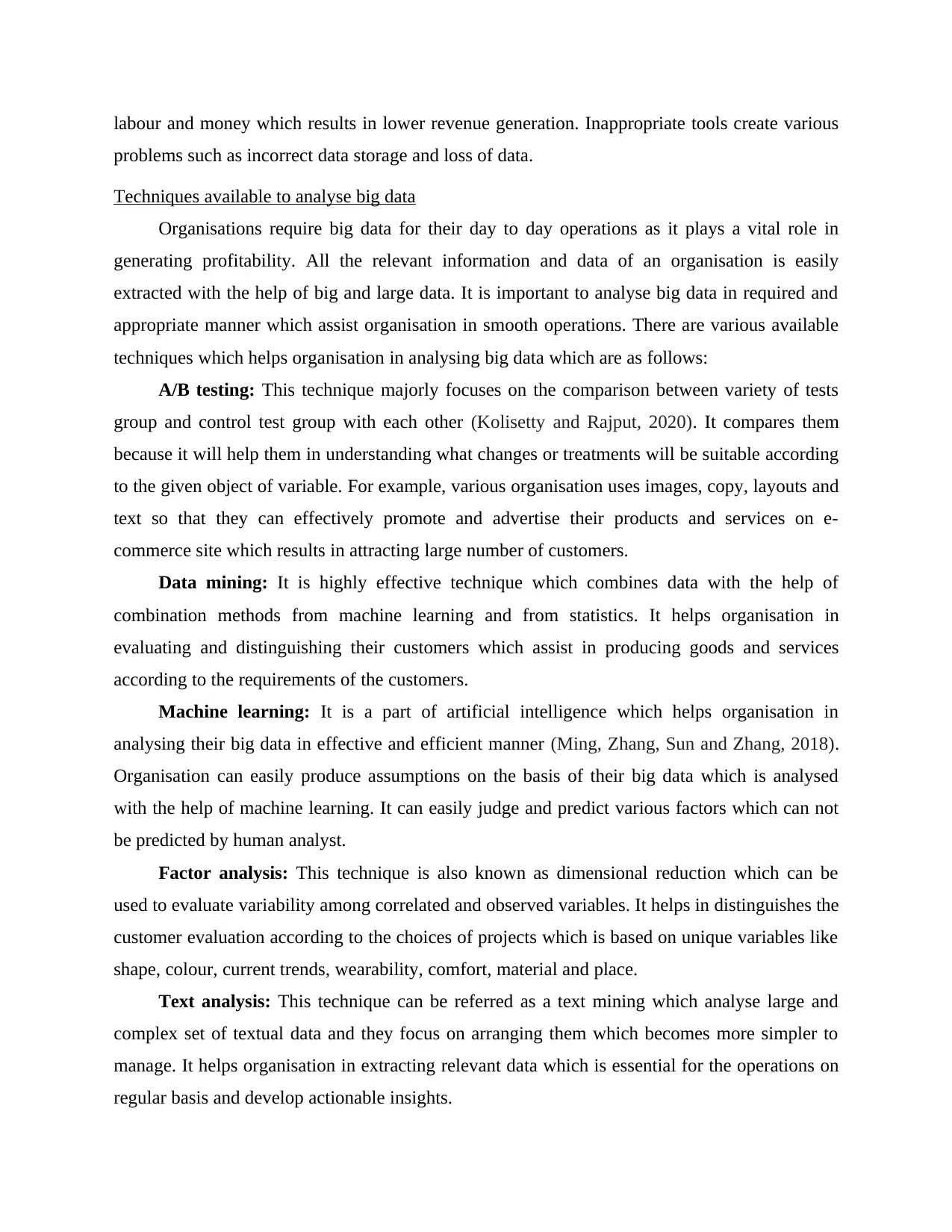
labour and money which results in lower revenue generation. Inappropriate tools create various
problems such as incorrect data storage and loss of data.
Techniques available to analyse big data
Organisations require big data for their day to day operations as it plays a vital role in
generating profitability. All the relevant information and data of an organisation is easily
extracted with the help of big and large data. It is important to analyse big data in required and
appropriate manner which assist organisation in smooth operations. There are various available
techniques which helps organisation in analysing big data which are as follows:
A/B testing: This technique majorly focuses on the comparison between variety of tests
group and control test group with each other (Kolisetty and Rajput, 2020). It compares them
because it will help them in understanding what changes or treatments will be suitable according
to the given object of variable. For example, various organisation uses images, copy, layouts and
text so that they can effectively promote and advertise their products and services on e-
commerce site which results in attracting large number of customers.
Data mining: It is highly effective technique which combines data with the help of
combination methods from machine learning and from statistics. It helps organisation in
evaluating and distinguishing their customers which assist in producing goods and services
according to the requirements of the customers.
Machine learning: It is a part of artificial intelligence which helps organisation in
analysing their big data in effective and efficient manner (Ming, Zhang, Sun and Zhang, 2018).
Organisation can easily produce assumptions on the basis of their big data which is analysed
with the help of machine learning. It can easily judge and predict various factors which can not
be predicted by human analyst.
Factor analysis: This technique is also known as dimensional reduction which can be
used to evaluate variability among correlated and observed variables. It helps in distinguishes the
customer evaluation according to the choices of projects which is based on unique variables like
shape, colour, current trends, wearability, comfort, material and place.
Text analysis: This technique can be referred as a text mining which analyse large and
complex set of textual data and they focus on arranging them which becomes more simpler to
manage. It helps organisation in extracting relevant data which is essential for the operations on
regular basis and develop actionable insights.
problems such as incorrect data storage and loss of data.
Techniques available to analyse big data
Organisations require big data for their day to day operations as it plays a vital role in
generating profitability. All the relevant information and data of an organisation is easily
extracted with the help of big and large data. It is important to analyse big data in required and
appropriate manner which assist organisation in smooth operations. There are various available
techniques which helps organisation in analysing big data which are as follows:
A/B testing: This technique majorly focuses on the comparison between variety of tests
group and control test group with each other (Kolisetty and Rajput, 2020). It compares them
because it will help them in understanding what changes or treatments will be suitable according
to the given object of variable. For example, various organisation uses images, copy, layouts and
text so that they can effectively promote and advertise their products and services on e-
commerce site which results in attracting large number of customers.
Data mining: It is highly effective technique which combines data with the help of
combination methods from machine learning and from statistics. It helps organisation in
evaluating and distinguishing their customers which assist in producing goods and services
according to the requirements of the customers.
Machine learning: It is a part of artificial intelligence which helps organisation in
analysing their big data in effective and efficient manner (Ming, Zhang, Sun and Zhang, 2018).
Organisation can easily produce assumptions on the basis of their big data which is analysed
with the help of machine learning. It can easily judge and predict various factors which can not
be predicted by human analyst.
Factor analysis: This technique is also known as dimensional reduction which can be
used to evaluate variability among correlated and observed variables. It helps in distinguishes the
customer evaluation according to the choices of projects which is based on unique variables like
shape, colour, current trends, wearability, comfort, material and place.
Text analysis: This technique can be referred as a text mining which analyse large and
complex set of textual data and they focus on arranging them which becomes more simpler to
manage. It helps organisation in extracting relevant data which is essential for the operations on
regular basis and develop actionable insights.
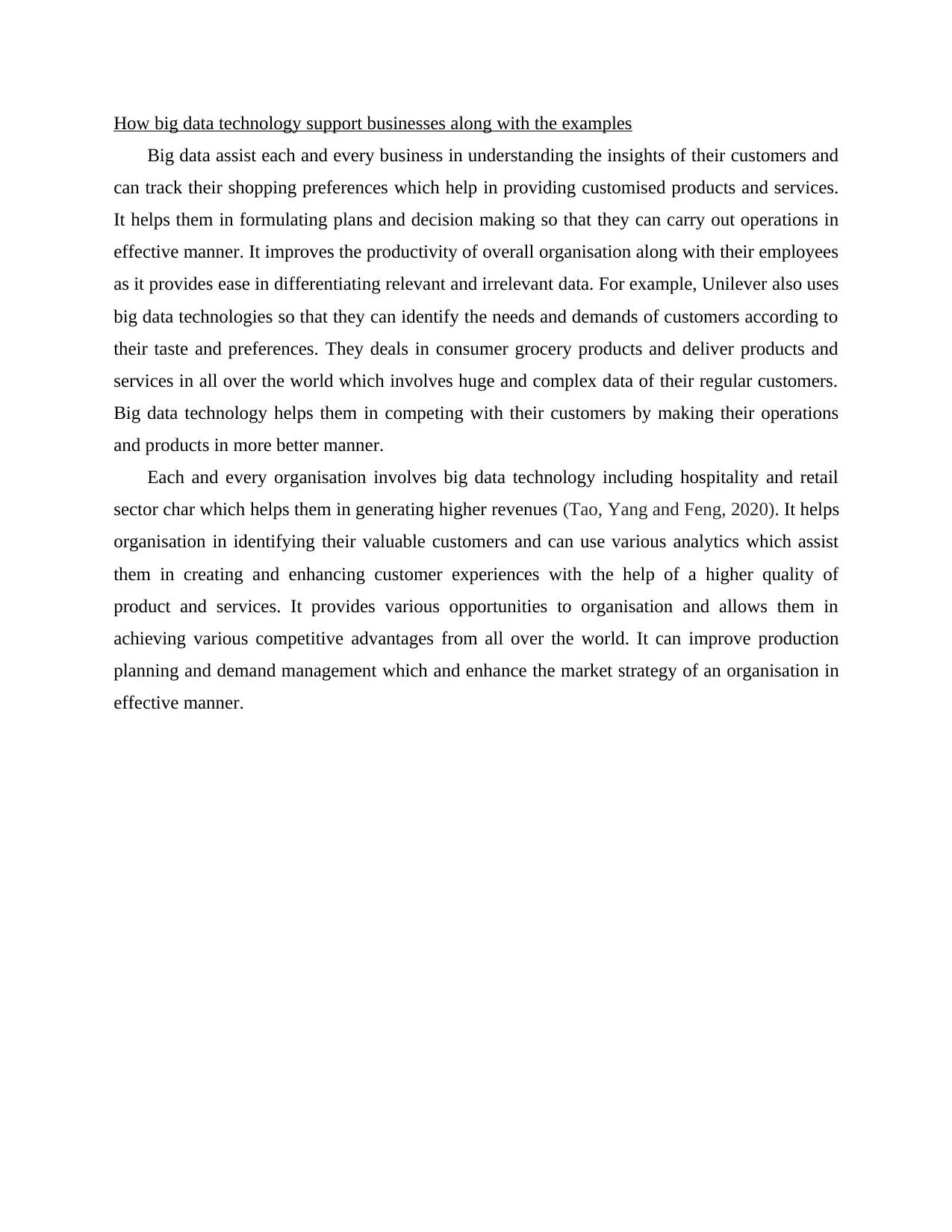
How big data technology support businesses along with the examples
Big data assist each and every business in understanding the insights of their customers and
can track their shopping preferences which help in providing customised products and services.
It helps them in formulating plans and decision making so that they can carry out operations in
effective manner. It improves the productivity of overall organisation along with their employees
as it provides ease in differentiating relevant and irrelevant data. For example, Unilever also uses
big data technologies so that they can identify the needs and demands of customers according to
their taste and preferences. They deals in consumer grocery products and deliver products and
services in all over the world which involves huge and complex data of their regular customers.
Big data technology helps them in competing with their customers by making their operations
and products in more better manner.
Each and every organisation involves big data technology including hospitality and retail
sector char which helps them in generating higher revenues (Tao, Yang and Feng, 2020). It helps
organisation in identifying their valuable customers and can use various analytics which assist
them in creating and enhancing customer experiences with the help of a higher quality of
product and services. It provides various opportunities to organisation and allows them in
achieving various competitive advantages from all over the world. It can improve production
planning and demand management which and enhance the market strategy of an organisation in
effective manner.
Big data assist each and every business in understanding the insights of their customers and
can track their shopping preferences which help in providing customised products and services.
It helps them in formulating plans and decision making so that they can carry out operations in
effective manner. It improves the productivity of overall organisation along with their employees
as it provides ease in differentiating relevant and irrelevant data. For example, Unilever also uses
big data technologies so that they can identify the needs and demands of customers according to
their taste and preferences. They deals in consumer grocery products and deliver products and
services in all over the world which involves huge and complex data of their regular customers.
Big data technology helps them in competing with their customers by making their operations
and products in more better manner.
Each and every organisation involves big data technology including hospitality and retail
sector char which helps them in generating higher revenues (Tao, Yang and Feng, 2020). It helps
organisation in identifying their valuable customers and can use various analytics which assist
them in creating and enhancing customer experiences with the help of a higher quality of
product and services. It provides various opportunities to organisation and allows them in
achieving various competitive advantages from all over the world. It can improve production
planning and demand management which and enhance the market strategy of an organisation in
effective manner.
⊘ This is a preview!⊘
Do you want full access?
Subscribe today to unlock all pages.

Trusted by 1+ million students worldwide
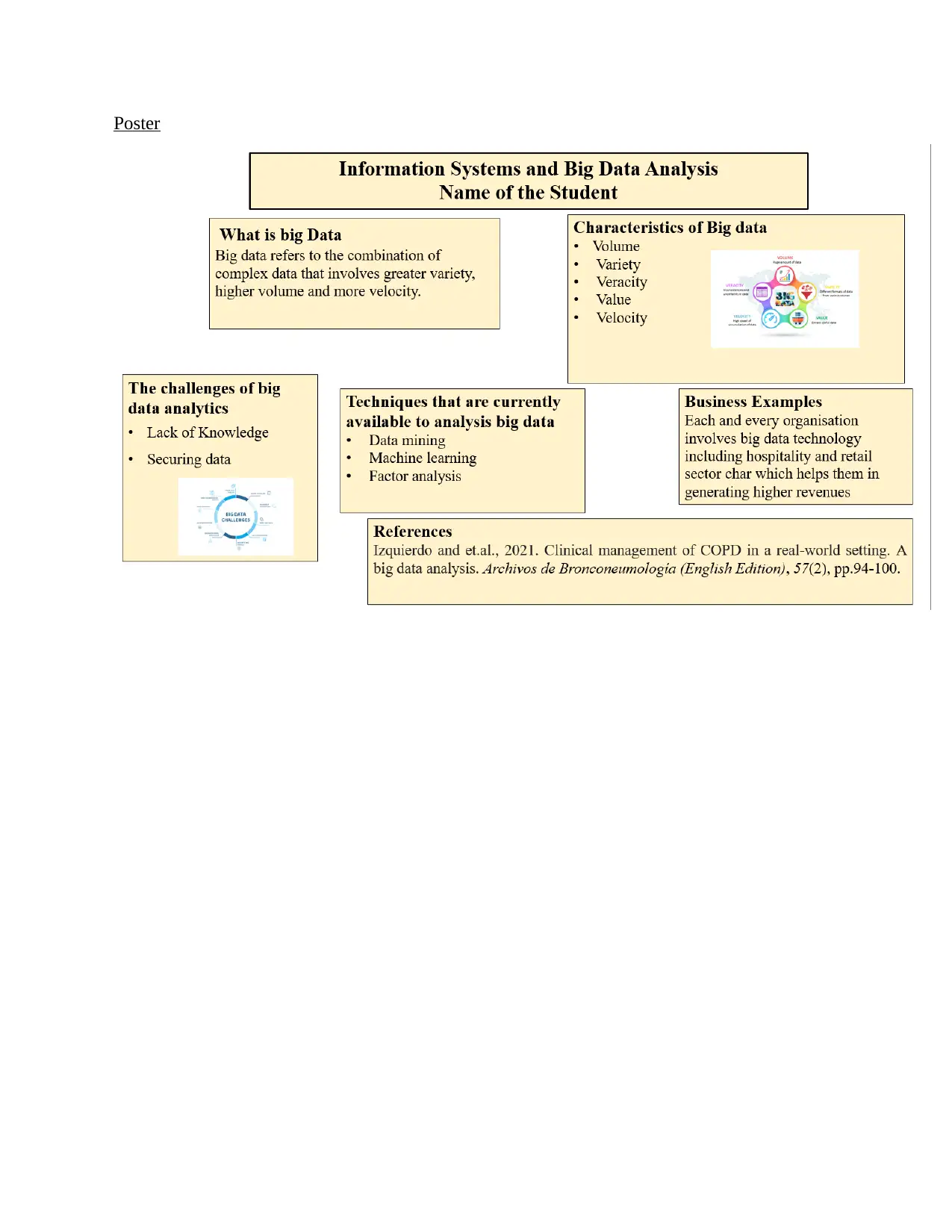
Poster
Paraphrase This Document
Need a fresh take? Get an instant paraphrase of this document with our AI Paraphraser
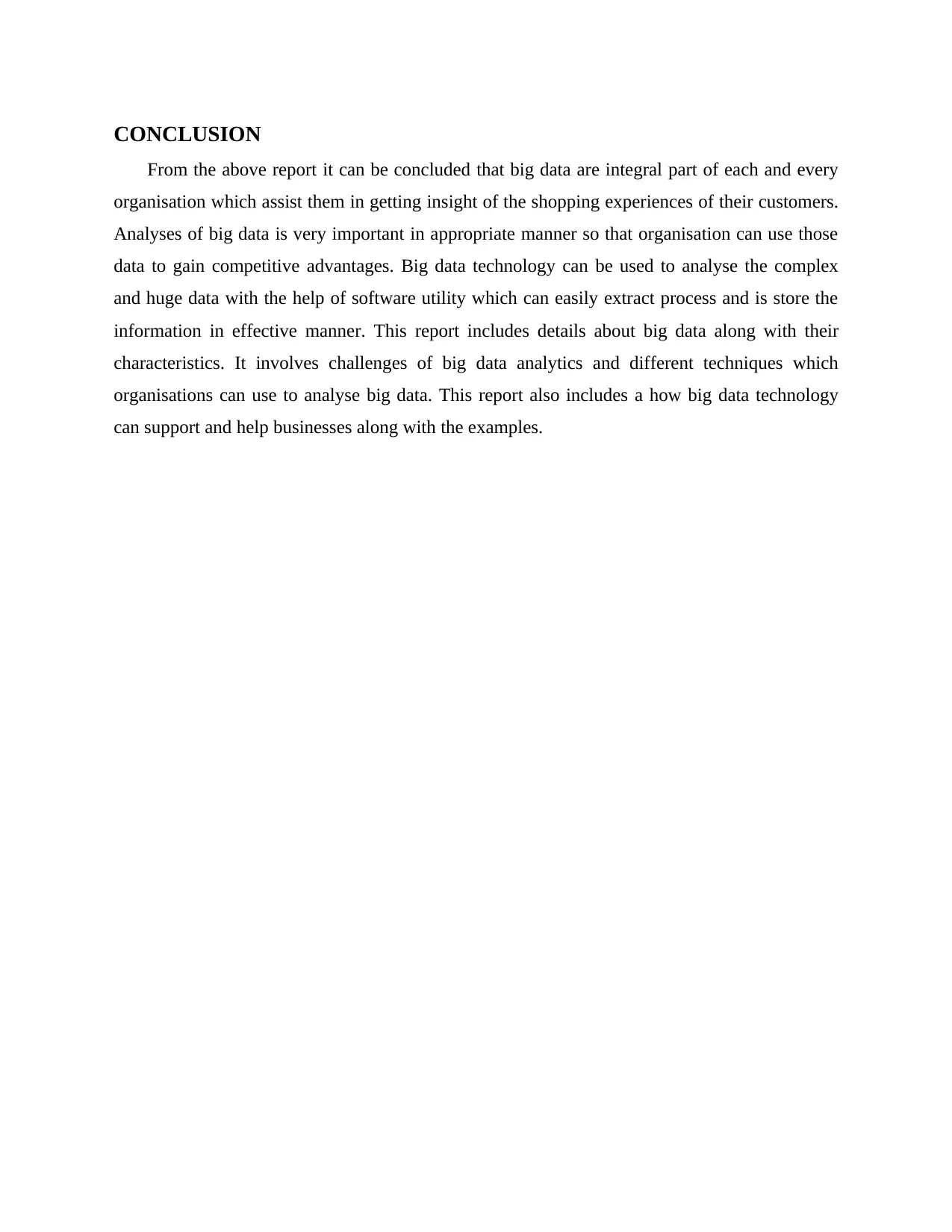
CONCLUSION
From the above report it can be concluded that big data are integral part of each and every
organisation which assist them in getting insight of the shopping experiences of their customers.
Analyses of big data is very important in appropriate manner so that organisation can use those
data to gain competitive advantages. Big data technology can be used to analyse the complex
and huge data with the help of software utility which can easily extract process and is store the
information in effective manner. This report includes details about big data along with their
characteristics. It involves challenges of big data analytics and different techniques which
organisations can use to analyse big data. This report also includes a how big data technology
can support and help businesses along with the examples.
From the above report it can be concluded that big data are integral part of each and every
organisation which assist them in getting insight of the shopping experiences of their customers.
Analyses of big data is very important in appropriate manner so that organisation can use those
data to gain competitive advantages. Big data technology can be used to analyse the complex
and huge data with the help of software utility which can easily extract process and is store the
information in effective manner. This report includes details about big data along with their
characteristics. It involves challenges of big data analytics and different techniques which
organisations can use to analyse big data. This report also includes a how big data technology
can support and help businesses along with the examples.
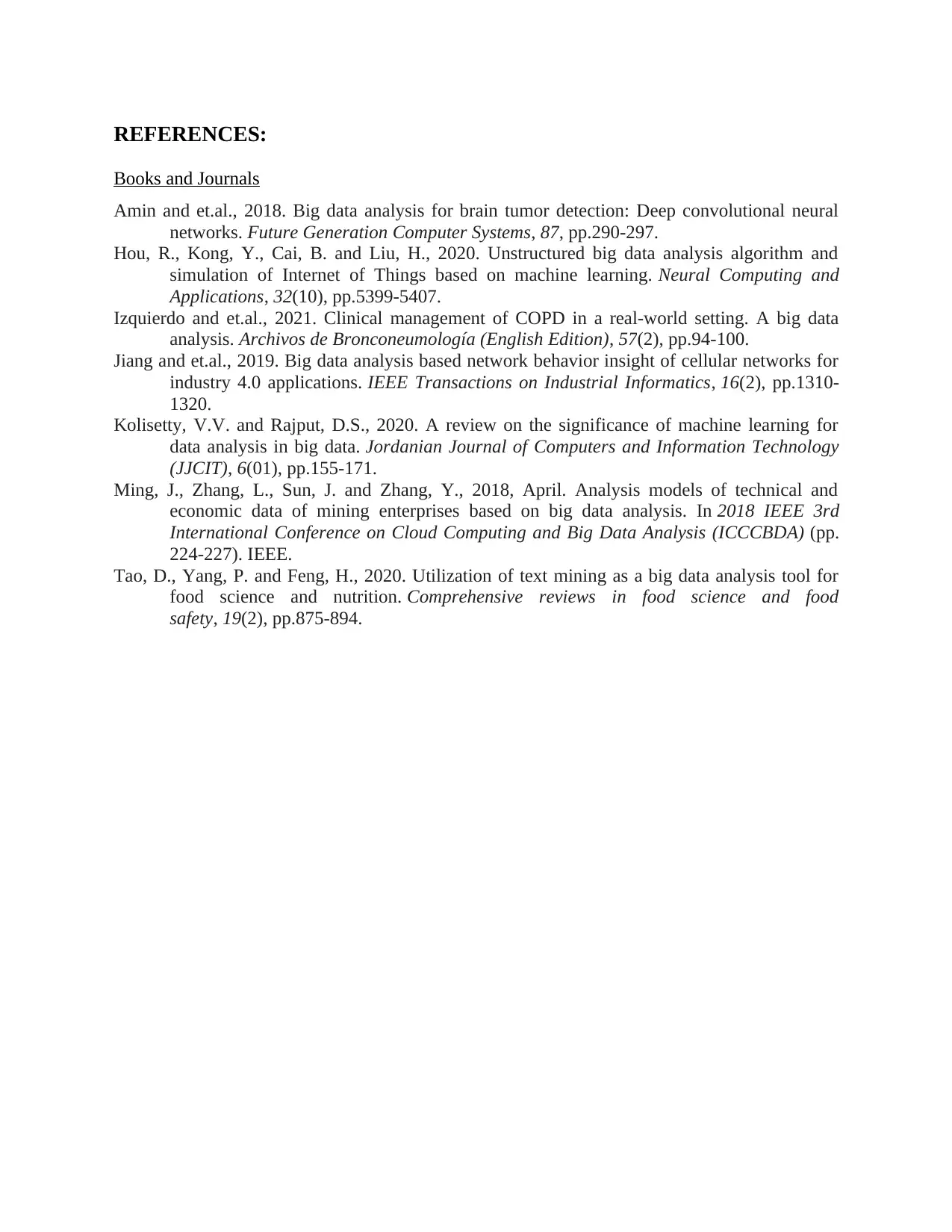
REFERENCES:
Books and Journals
Amin and et.al., 2018. Big data analysis for brain tumor detection: Deep convolutional neural
networks. Future Generation Computer Systems, 87, pp.290-297.
Hou, R., Kong, Y., Cai, B. and Liu, H., 2020. Unstructured big data analysis algorithm and
simulation of Internet of Things based on machine learning. Neural Computing and
Applications, 32(10), pp.5399-5407.
Izquierdo and et.al., 2021. Clinical management of COPD in a real-world setting. A big data
analysis. Archivos de Bronconeumología (English Edition), 57(2), pp.94-100.
Jiang and et.al., 2019. Big data analysis based network behavior insight of cellular networks for
industry 4.0 applications. IEEE Transactions on Industrial Informatics, 16(2), pp.1310-
1320.
Kolisetty, V.V. and Rajput, D.S., 2020. A review on the significance of machine learning for
data analysis in big data. Jordanian Journal of Computers and Information Technology
(JJCIT), 6(01), pp.155-171.
Ming, J., Zhang, L., Sun, J. and Zhang, Y., 2018, April. Analysis models of technical and
economic data of mining enterprises based on big data analysis. In 2018 IEEE 3rd
International Conference on Cloud Computing and Big Data Analysis (ICCCBDA) (pp.
224-227). IEEE.
Tao, D., Yang, P. and Feng, H., 2020. Utilization of text mining as a big data analysis tool for
food science and nutrition. Comprehensive reviews in food science and food
safety, 19(2), pp.875-894.
Books and Journals
Amin and et.al., 2018. Big data analysis for brain tumor detection: Deep convolutional neural
networks. Future Generation Computer Systems, 87, pp.290-297.
Hou, R., Kong, Y., Cai, B. and Liu, H., 2020. Unstructured big data analysis algorithm and
simulation of Internet of Things based on machine learning. Neural Computing and
Applications, 32(10), pp.5399-5407.
Izquierdo and et.al., 2021. Clinical management of COPD in a real-world setting. A big data
analysis. Archivos de Bronconeumología (English Edition), 57(2), pp.94-100.
Jiang and et.al., 2019. Big data analysis based network behavior insight of cellular networks for
industry 4.0 applications. IEEE Transactions on Industrial Informatics, 16(2), pp.1310-
1320.
Kolisetty, V.V. and Rajput, D.S., 2020. A review on the significance of machine learning for
data analysis in big data. Jordanian Journal of Computers and Information Technology
(JJCIT), 6(01), pp.155-171.
Ming, J., Zhang, L., Sun, J. and Zhang, Y., 2018, April. Analysis models of technical and
economic data of mining enterprises based on big data analysis. In 2018 IEEE 3rd
International Conference on Cloud Computing and Big Data Analysis (ICCCBDA) (pp.
224-227). IEEE.
Tao, D., Yang, P. and Feng, H., 2020. Utilization of text mining as a big data analysis tool for
food science and nutrition. Comprehensive reviews in food science and food
safety, 19(2), pp.875-894.
⊘ This is a preview!⊘
Do you want full access?
Subscribe today to unlock all pages.

Trusted by 1+ million students worldwide
1 out of 9
Related Documents
Your All-in-One AI-Powered Toolkit for Academic Success.
+13062052269
info@desklib.com
Available 24*7 on WhatsApp / Email
![[object Object]](/_next/static/media/star-bottom.7253800d.svg)
Unlock your academic potential
Copyright © 2020–2025 A2Z Services. All Rights Reserved. Developed and managed by ZUCOL.

